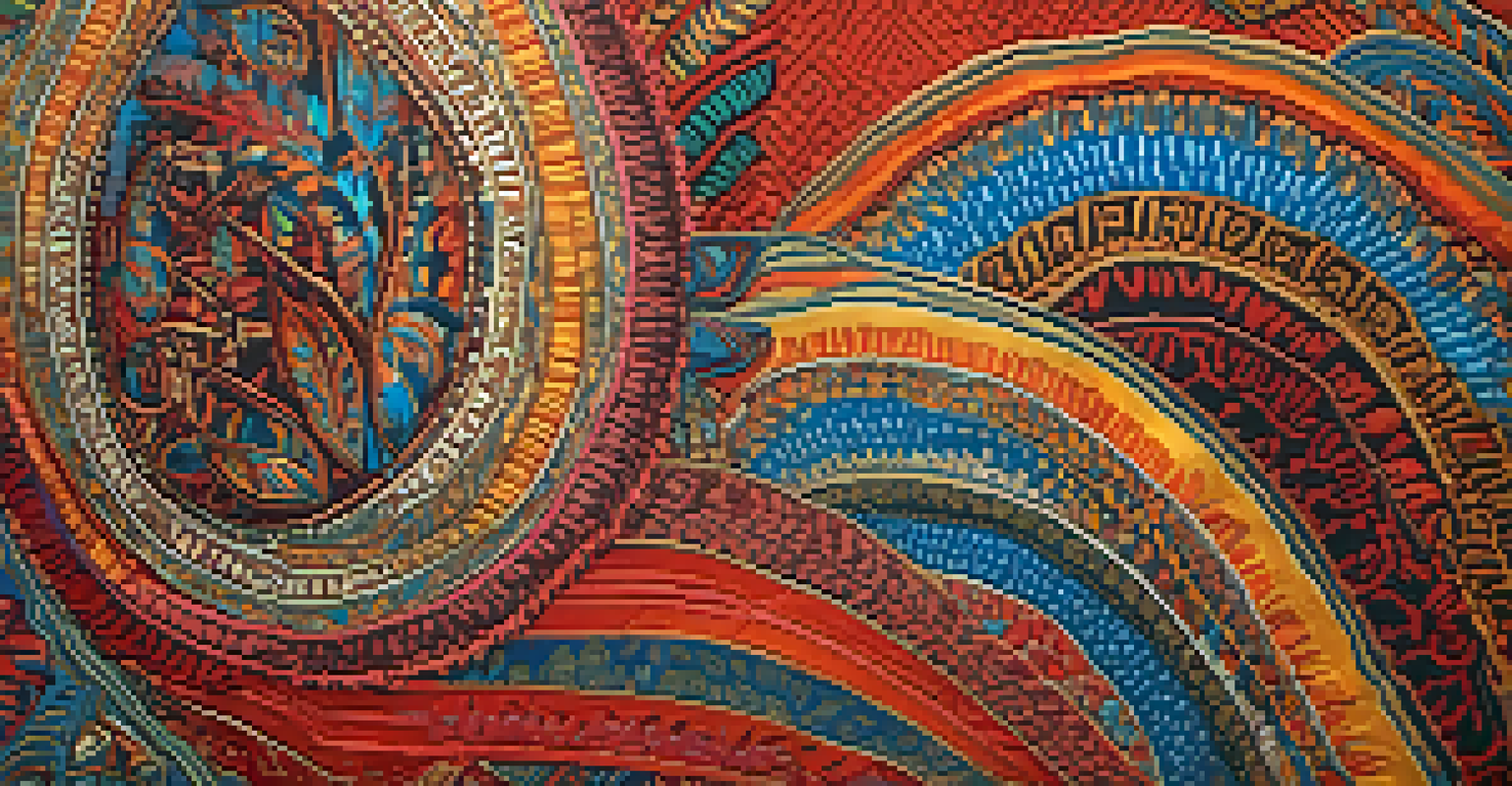How Globalization Influenced Fashion Trends Across Decades

Defining Globalization and Its Role in Fashion
Globalization refers to the interconnectedness of economies, cultures, and societies across the world. In the realm of fashion, this phenomenon has allowed for the exchange of ideas, materials, and styles, significantly influencing what we wear. As cultures blend, we see the emergence of trends that reflect a mosaic of influences rather than singular styles.
Fashion is the armor to survive the reality of everyday life.
This interconnectedness means that a fashion trend originating in one part of the world can quickly become a global sensation. For instance, the rise of streetwear has roots in urban American culture but has been adopted and adapted by fashion enthusiasts worldwide. The result is a dynamic and ever-evolving landscape where fashion is not just local but global.
Understanding globalization's role in fashion helps us appreciate the diverse influences that shape our wardrobes. It’s a reminder that what we wear is often a reflection of a larger cultural conversation, one that transcends boundaries and celebrates diversity.
The 1960s: A Time of Liberation and Cultural Exchange
The 1960s marked a significant turning point in fashion, driven by the youth culture's desire for liberation and self-expression. This decade saw the rise of the 'mod' style in the UK, characterized by bold prints and tailored suits, which quickly spread to the US and beyond. The influence of music, particularly bands like The Beatles, played a crucial role in shaping these trends.

Globalization during this time was evident through the influx of Eastern styles, such as Indian fabrics and patterns, which were embraced by Western designers. The psychedelic prints and flowing garments were not just fashion statements; they symbolized a broader cultural shift towards acceptance and experimentation. The blending of Eastern and Western influences created a unique fashion landscape that defined the decade.
Globalization Shapes Fashion Trends
The interconnectedness of cultures has led to the rapid exchange and evolution of fashion styles worldwide.
The 1960s illustrate how globalization can foster creativity and innovation in fashion. It was a period where cultural exchange was celebrated, leading to styles that were vibrant, eclectic, and reflective of the times' spirit.
The 1970s: Embracing Diversity and Individuality
As we moved into the 1970s, fashion became a canvas for individuality and self-expression, influenced by the global movement of ideas. The rise of disco culture brought with it a flair for the extravagant, with bright colors, sequins, and bold patterns becoming staples in wardrobes. At the same time, traditional clothing from various cultures began to be embraced in mainstream fashion.
Globalization is not a choice, it's a necessity.
This decade saw the popularity of bohemian styles, which drew inspiration from various global cultures, including Native American and African elements. The fusion of these styles reflected a growing appreciation for diversity in fashion, as well as a desire to break away from conventional norms. Designers began to explore textiles and patterns from around the world, creating a fashion scene that was rich in cultural references.
The 1970s remind us that globalization can lead to a celebration of diversity. By incorporating various cultural influences, fashion became a means of expressing one’s identity and beliefs, paving the way for future decades to continue this trend of inclusivity.
The 1980s: Global Fashion Icons and Mass Production
The 1980s ushered in an era dominated by global fashion icons and the rise of mass production. This decade was characterized by bold silhouettes, power dressing, and an explosion of brands that transcended borders. Global superstars like Madonna and Michael Jackson not only influenced music but also set fashion trends that echoed worldwide.
With advancements in technology and manufacturing, fashion became more accessible than ever before. Designers could produce clothing at a rapid pace, leading to the phenomenon of fast fashion. This allowed consumers to quickly adopt and discard trends, creating a cycle of constant change in the fashion industry.
Decades of Cultural Exchange in Fashion
Fashion trends from the 1960s through the 2010s illustrate how cultural influences have fostered creativity and diversity.
The 1980s highlighted the powerful role of globalization in shaping not just styles but also consumer behavior. It was a decade where fashion became a universal language, with trends that crossed oceans and cultures, marking a new era in the way we perceive and consume fashion.
The 1990s: The Rise of Streetwear and Global Influences
The 1990s saw the emergence of streetwear as a dominant force in fashion, heavily influenced by globalization and youth culture. This trend was rooted in urban environments, particularly in cities like Los Angeles and New York, where hip-hop and skate culture flourished. The styles were often casual, featuring oversized clothing, graphic tees, and sneakers, making them accessible to the masses.
Globalization played a critical role as brands began to draw inspiration from international cultures. Designers started to incorporate elements from Japanese street fashion, African prints, and European high fashion into their collections. This blending of influences not only diversified fashion but also made it more relatable to a wider audience.
The 1990s remind us that globalization can democratize fashion, making it available and appealing to various groups. Streetwear became a symbol of rebellion and individuality, reflecting a generation that valued authenticity and cultural expression.
The 2000s: Fast Fashion and the Global Marketplace
The 2000s marked the peak of fast fashion, a phenomenon fueled by globalization and the demand for quick turnaround on trends. Retailers like Zara and H&M made it possible for consumers to access the latest styles at affordable prices, leading to a dramatic shift in consumer behavior. This era was defined by the idea that you could wear the latest runway looks without breaking the bank.
However, this rapid production and consumption came with significant consequences, including environmental concerns and the ethical implications of labor practices in developing countries. As awareness of these issues grew, so did the desire for more sustainable and ethical fashion choices. Globalization made these conversations possible, connecting consumers with the origins of their clothing.
Future Focus on Sustainability
As globalization continues, the fashion industry must prioritize ethical practices and sustainability to meet consumer demands.
The 2000s serve as a crucial reminder that globalization can have both positive and negative impacts on the fashion industry. While it made fashion more accessible, it also prompted a critical examination of the industry’s practices and their effects on the planet.
The 2010s: Sustainability and Cultural Appreciation
As we entered the 2010s, the fashion industry began to pivot towards sustainability and ethical practices, largely influenced by globalization. Consumers became more conscious of the environmental and social impacts of their purchases, leading to a demand for transparency from brands. This shift highlighted the interconnectedness of global supply chains and the responsibility of consumers to make informed choices.
During this decade, there was also a renewed appreciation for cultural influences in fashion, but with an emphasis on respecting and celebrating those cultures rather than appropriating them. Designers started collaborating with artisans from various backgrounds, creating collections that honored traditional craftsmanship while appealing to a global audience.

The 2010s illustrated how globalization can foster not just trends, but also a greater understanding of cultural heritage. It marked a time when fashion became a platform for activism and awareness, reminding us that what we wear can reflect our values and beliefs.
Looking Ahead: The Future of Fashion in a Globalized World
As we look to the future, the influence of globalization on fashion trends will likely continue to evolve. With technology advancing rapidly, we can expect to see even more innovative ways for cultures to connect and share their styles. Social media platforms play a vital role in this, allowing trends to spread like wildfire across the globe.
However, the fashion industry will need to navigate the challenges of sustainability and ethical production to ensure a positive impact on the world. As consumers become increasingly aware of their choices, brands will be called upon to prioritize values that align with the growing demand for responsible fashion. This could lead to a more conscious approach to globalization.
The future of fashion promises to be an exciting blend of creativity, cultural appreciation, and responsibility. As we embrace globalization, we must also recognize our role in shaping a fashion landscape that respects and celebrates the rich tapestry of influences from around the world.